Can Medical Transcription Services Improve Telemedicine Practices?
Oct 24, 2019 | Jonathan Maisel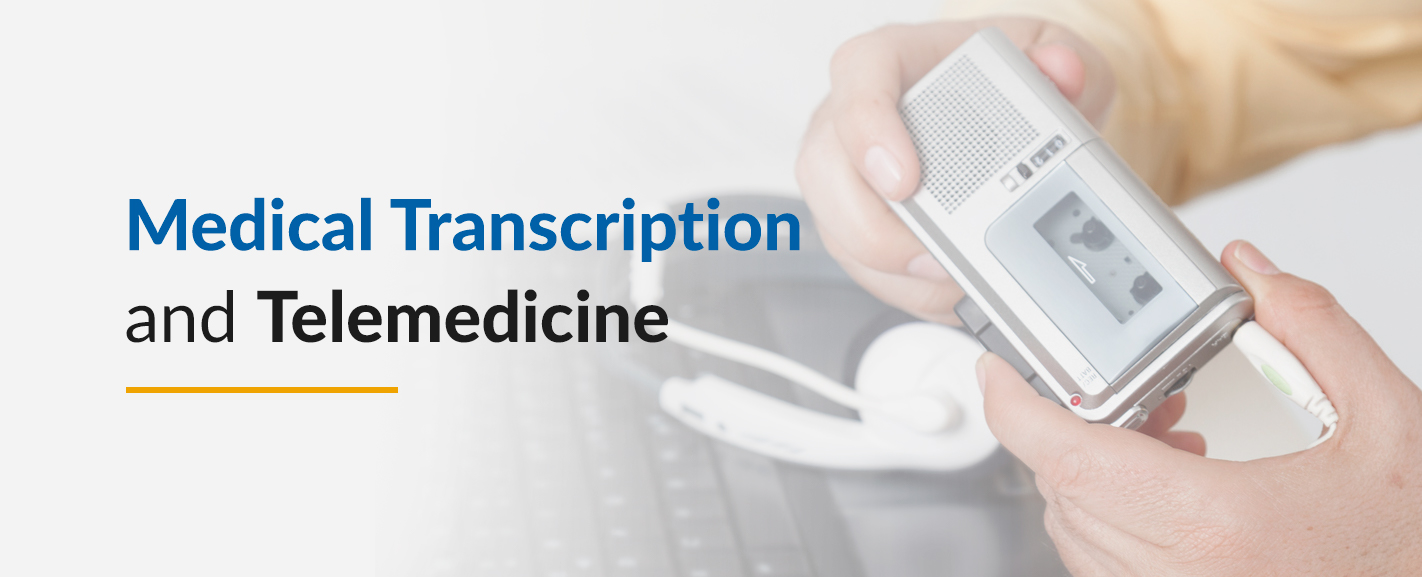
Most people go to the doctor’s office every once in a while. Whether our ailment is a broken finger, a case of the flu or something more serious, the doctor’s office usually knows how to get us back on track.
But did you know that some doctor’s offices aren’t physical offices at all? With telemedicine, patients can have a video consultation with a doctor instead of going into an actual office. Patients can describe their conditions and demonstrate easily visible symptoms, like skin rashes, through the video chat module. Some telemedicine systems also offer ways for patients to transmit vital signs such as heartbeat sounds, blood pressure readings and other data during these “electronic house calls.”
Telemedicine is growing fast. The American Hospital Association reports that in 2010, the percentage of hospitals implementing any form of computerized telemedicine service was modest, at only 35%. By 2017, however, that number had leaped to more than double, with 76% of hospitals relying on either full or partial computerized telemedicine systems. The telemedicine market is expected to hit an impressive $130 billion by 2025, rising tremendously from the $38.3 billion current market.
For some conditions in which an in-person examination is necessary, telemedicine is not a practical solution. But for many patients, telemedicine is a great, convenient way to save time, avoid hassles and keep away from the germs they might encounter while going to a hospital or clinic.
How Telemedicine Is Changing the Medical Industry
Several decades ago, telemedicine had limited applications. It was typically used to provide medical care to patients who lived in remote locations and could not easily get to a doctor’s office or hospital.
Telemedicine in the 1950s, ’60s and ’70s
The use of video communications in medicine began at the University of Nebraska–Lincoln (UNL) in 1959. In that year, doctors transmitted the results of neurological exams across campus using interactive two-way television. A few years later, in 1964, they expanded the technology to deliver health services to a hospital located over a hundred miles from campus, the Norfolk State Hospital in Norfolk, Nebraska. The UNL doctors used this basic telecommunications service to provide speech therapy, diagnose complicated psychiatric cases, perform neurological examinations, consult with colleagues and offer professional development training.
Even before that, basic teleradiology work had already begun. In 1948, using a telephone, doctors in Pennsylvania transmitted radiographs over a distance of 24 miles, between Philadelphia and West Chester. In the early 1950s, doctors in Montreal built on this technology and created a teleradiology system for use in the Jean-Talon Hospital.
Although telemedicine technology was initially designed to reach remote populations with medical care, urban applications also appeared early on. In 1963, Massachusetts General Hospital (MGH) in Boston developed a telecommunications link with a medical station at Logan Airport, located a couple of miles away on a peninsula jutting into Boston Harbor. A few years later, MGH also developed an interactive television microwave link that transmitted microscope images, stethoscope data and electrocardiograph rhythms. Not satisfied with these technological breakthroughs, MGH also added a link to the Veterans Administration Hospital in Bedford, Massachusetts, to provide telepsychiatry services. That link remained in operation until the 1980s.
Around the same time, doctors at the University of Miami School of Medicine partnered with the Miami fire department for pioneering work on the transmission of electrocardiograph rhythms via radio channels. This technology proved so useful that it quickly went mainstream and is now rarely thought of as a part of telemedicine.
In the 1960s and ’70s, an incredible and unlikely partnership between two very different sectors of the federal government took telemedicine to a whole new level. NASA and the Lockheed Company, the forerunner of today’s aerospace and defense company Lockheed Martin, partnered with the U.S. Indian Health Service to form an organization known as the STARPAHC project, or Space Technology Applied to Rural Papago Advanced Health Care. This innovative project applied telemedicine technology used by NASA astronauts in space to provide health care to Native American residents on a remote reservation. This collaborative venture lasted for a fruitful 20 years.
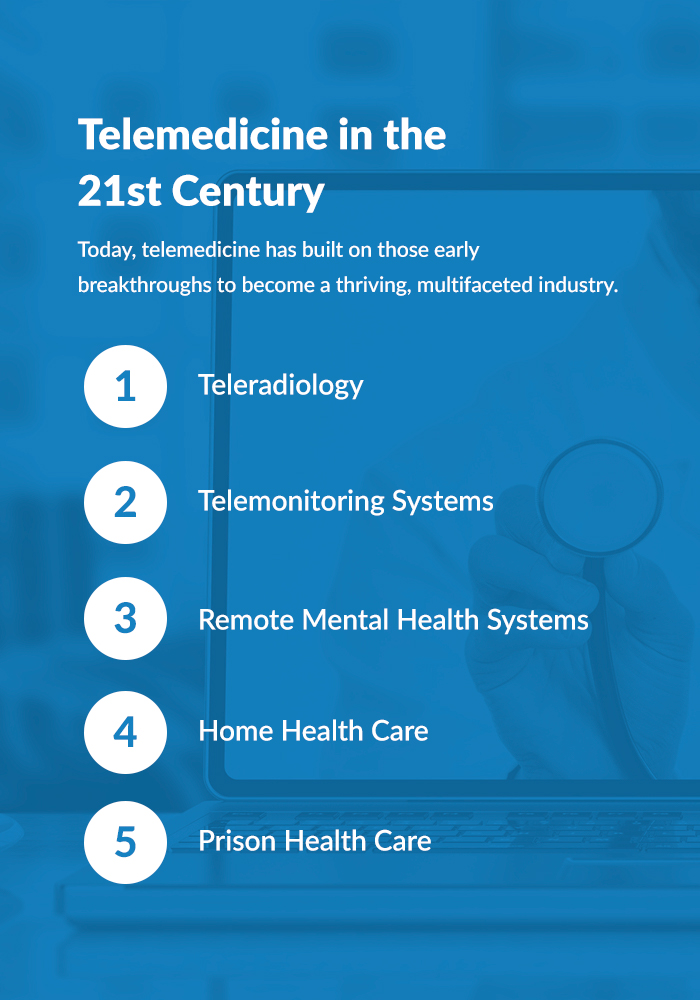
Telemedicine Opportunities in the 21st Century
Today, telemedicine has built on those early breakthroughs to become a thriving, multifaceted industry.
1. Teleradiology
One of the most common applications for telemedicine is teleradiology. Widespread use of teleradiology is possible because the field of radiology is so image-oriented, and images are easy to transmit electronically. It is also possible because insurance systems, such as Medicare, are often willing to pay for a remote radiology consultation. In many other specialties, they require an in-person visit before they will process any claims.
Teleradiology uses telecommunications to transmit radiographs, or X-rays, of broken bones and other internal ailments. The process of teleradiology includes steps such as producing digital images or converting film images to a digital format, tagging the images with patient information, compressing the images to a transmissible size, transmitting them and reconstituting them miles away for evaluation and diagnosis. Fewer film images become lost this way. Radiologists can also often have images sent to their work laptops so they don’t have to drive to the hospital to view them when they are on call.
2. Telemonitoring Systems
Additionally, telephones can be part of monitoring services in a form of telemedicine. The VA medical centers in San Francisco and Washington, D.C., have operated telephone pacemaker monitoring systems since 1962. The monitoring systems work like this — pacemakers are designed to transmit at a different frequency when they are running low on battery power. An electrocardiogram (ECG) can detect the difference. A device can be attached to a telephone and transmit ECG readings to a health clinic, which can then diagnose the issue without seeing the patient in person.
Other monitoring systems use radio technology to check on whether elderly patients rise after their alarm clocks ring or to monitor patients who might fall in their homes.
3. Remote Mental Health Systems
Telemedicine also has applications for providing critical mental health services to isolated populations. One successful program in this area is the Rural Options for Development and Educational Opportunities Network (RODEO NET). This program uses telecommunications to deliver mental health services in rural eastern Oregon, allowing for patient evaluations, specialist consultations and crisis response.
4. Home Health Care
Video-based home health applications are less common, but they do exist. In these settings, patients can sit in front of a home video system or webcam and use videoconferencing technology to speak directly with a physician or nurse practitioner about their symptoms.
5. Prison Health Care
Telemedicine has additional applications for the prison population. On-site prison medical staff resources are limited, and off-site visits are costly. Off-site care also comes with logistical and security risks. Through the use of telemedicine, it is possible to provide the at-risk prison population with quality health care without draining resources or arranging complex and expensive transfers between prison and hospital facilities.
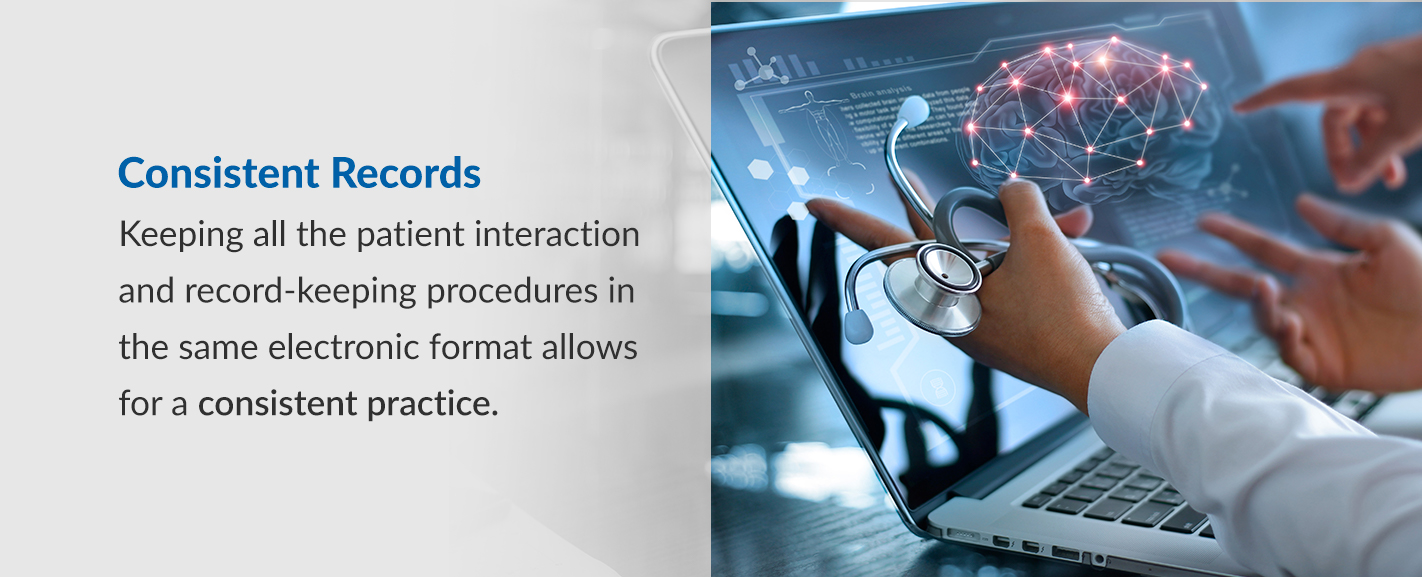
Managing Telemedicine Patient Files
Managing patient files properly in the era of telemedicine is vital. With more ways to provide and convey information, each piece of data needs to be documented so no crucial information goes missing. It’s also necessary to convert audio dictation files into official transcriptions for patient files.
Additionally, it’s imperative to keep all of a patient’s sensitive medical information confidential. All telemedicine procedures and record-keeping should take place over a secure network and comply with HIPAA privacy requirements. Under the terms of HIPAA, patients can request access and emendations to their medical records. These requests can also complicate the process of managing telemedicine patient files.
Managing telemedicine patient files is also important for insurance purposes. Before they will pay for telemedicine procedures, many insurance companies require a level of documentation equal to what they would receive for an in-person office visit. If this documentation is lacking, the insurance company will likely deny payment of claims.
Before the advent of telemedicine, maintaining a patient file was a straightforward process. The file consisted of paper health and billing records, along with copies of any images such as x-rays or ultrasounds.
Now, however, knowing what to include in a patient file is more complicated. The American Health Information Management Association (AHIMA) suggests that telemedicine patient files should be as similar to office patient files as possible. Forms should be the same, for example, with small modifications where necessary.
AHIMA recommends the following minimum requirements for inclusion in telemedicine records:
- Patient name
- ID number
- Date of appointment
- Referring medical professional
- Consulting medical professional
- Provider organization
- Type of evaluation
- Proof of informed consent
- Exam results
- Findings and diagnosis
- Recommendations for treatment
According to AHIMA, the medical records for telemedicine patients may consist of paper copies, video or audiotapes, monitor strips or electronic files. No matter what type of media and organization system a provider chooses, all the components of a patient’s file should remain together and be easy to assemble when the file is needed.
Additionally, states may impose their own requirements for materials included in telemedicine patient files. They may also specify the types of media that are acceptable for inclusion in these files. Providers should follow these state requirements as well.
How Medical Transcription Services Help Telemedicine Practices
Medical transcription services play an essential role in telemedicine practices. As with traditional medicine, telemedicine requires a substantial amount of records documentation. This documentation is crucial because it allows for the timely transmission of thorough records between professionals who may well be thousands of miles apart. Medical transcription offers a way to make this process faster and easier. It frees health care professionals’ valuable time so they can provide more quality patient care.
1. Integration With EMRs
Many practices have now adopted electronic medical records (EMRs), also known as electronic health records (EHRs), rather than paper records. This is particularly true where telemedicine is involved. EMRs are beneficial because, unlike paper records, they cannot be destroyed in a flood or fire. They are also easily shareable, transmissible with a few keystrokes and clicks of a mouse. For this reason, they are very useful when patient care requires a scattered team of providers who all need reliable access to the patient’s records.
Telemedicine and EHRs integrate seamlessly with medical transcription. Medical transcription typically involves turning a physician or nurse practitioner’s audio dictation file into an electronic text file. This transcription file is then easy to read and search. Most EHR systems can easily accommodate these files, and many transcription services automatically upload their completed files into the correct portion of the EHR system. This seamless automation saves time and labor for busy medical professionals. For this reason, telemedicine and EHRs interface wonderfully.
2. HIPAA Compliance and Security
Medical transcription services also help telemedicine practices by ensuring patient privacy and protection. Because of the internet-based nature of much of their work, telemedicine practices need to ensure that no personal patient information leaks out of the office or becomes vulnerable to hacking.
Medical transcription services aid in this goal because all of their transmissions take place over a secure network, no matter whether they are receiving or uploading a file. The secure transmissions ensure that sensitive patient details remain confidential and protected. Reputable medical transcription services always ensure that their services are secure and compliant with HIPAA.
3. Consistent Records
Keeping all the patient interaction and record-keeping procedures in the same electronic format allows for a consistent practice. With electronic medical transcription, if a doctor is preparing for surgery, there’s no need to review the recorded video and then change gears to dig through piles of paper reports. The doctor can simply store and find all of the electronic data in one place on the network.
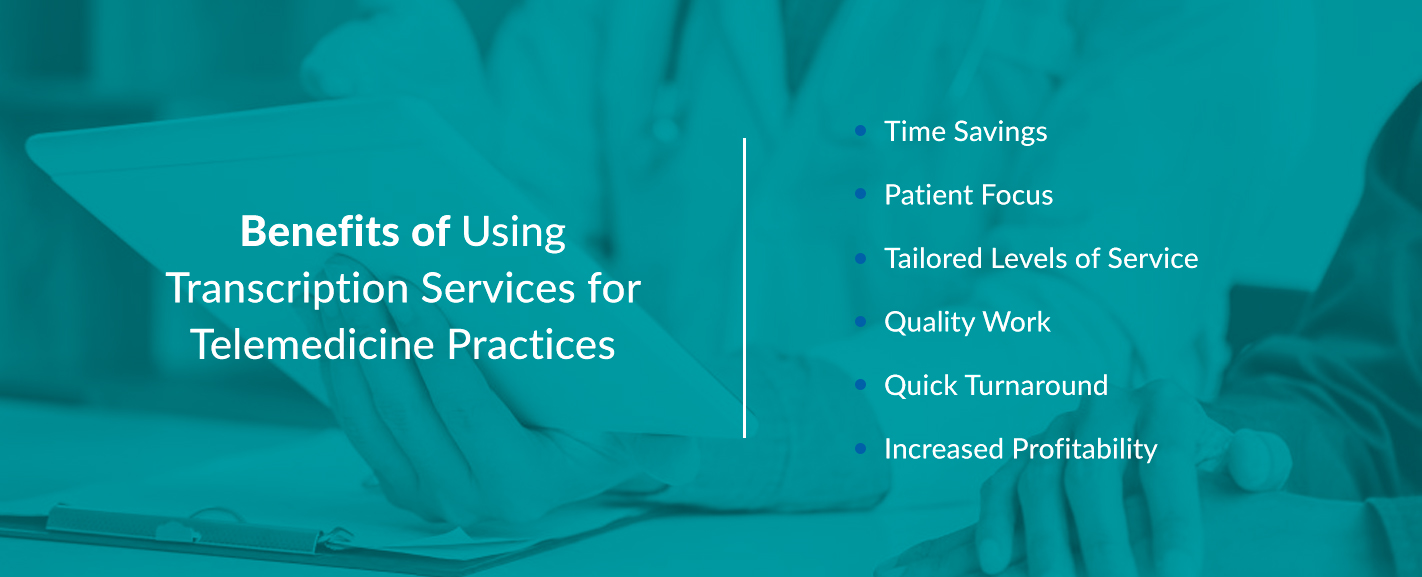
Benefits of Using Transcription Services for Telemedicine Practices
Using medical transcription for telemedicine practices provides the following specific advantages:
1. Time Savings
Telemedicine practitioners often find their attention pulled in many different directions. They might first evaluate a patient in a remote location, then consult with a practitioner a few towns away and then manage a crisis at a local emergency room. In this environment, time is at a premium. Physicians and nurse practitioners sometimes struggle to make time for the cumbersome work of transcribing their notes, but medical transcription service takes this burden from them, freeing their time for the practice of medicine.
2. Patient Focus
Medical transcription services help telemedicine practices put the focus back on patients. Doctors who are busy with desk work experience higher-than-average levels of stress and even burnout. Often, they can be too distracted with the demands of transcription and desk work to focus as much as they would like to on patient care. A medical transcription service can make a tremendous difference.
3. Tailored Levels of Service
Different types of practices can choose what level of service they need. In a telemedicine practice focusing on in-home patient care, the pace of the work may be slower. The terminology may be more routine, and physicians may have more time to review transcriptions for errors. These telemedicine practices may opt for a standard level of transcription service. On the other hand, a busy teleradiology practice that uses hyper-specialized terminology may opt for a premium package with a more stringent level of editorial oversight. The flexibility to choose the options that are best for each telemedicine practice makes transcription services appealing.
4. Quality Work
If a telemedicine practice hires a medical assistant for transcription, the new employee is not guaranteed to be fluent in medical terminology. The professional transcriptionists employed at medical transcription services, however, receive rigorous, detailed training in medical terminology and context. They are more likely to return correct files to a telemedicine practice because they have the level of specialized knowledge necessary to do quality work.
5. Quick Turnaround
When telemedicine practices serve patients in extremely remote locations, they are frequently the only form of medical care these patients can access. In these situations, a quick response is often vital to providing care and preventing a routine case from escalating into a life-or-death situation. Medical transcription services facilitate this work with their quick turnaround guarantees. Many services offer turnaround times of 24 hours and can even offer swifter STAT turnarounds for a modest additional fee.
6. Increased Profitability
Most clinics are in business to help their patients, but they can’t continue to operate if they don’t bring in enough money to cover their expenses and pay their staff. This is especially true for telemedicine practices. As less established practices than traditional, in-person clinics, they may not immediately bring in enough patients to see a comfortable profit margin. But transcription services can help.
The salary and benefit costs to employ an in-house medical assistant or professional transcriptionist, for example, can be prohibitive. But medical transcription services typically charge only a few cents per line of transcription. This affordability makes medical transcription services exceptionally appealing to telemedicine practices.
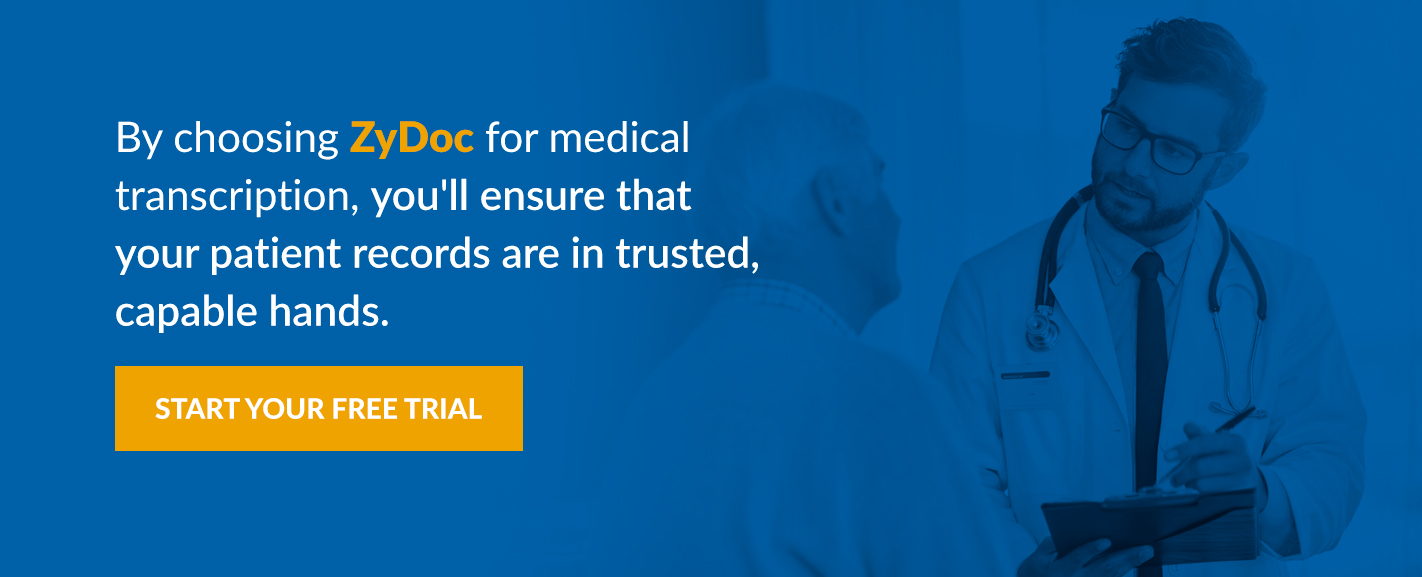
Start a Free Trial of ZyDoc’s Medical Transcription Services for Your Telemedicine Practice
For a free trial of medical transcription services for your telemedicine practice, look no further than ZyDoc. By choosing ZyDoc for medical transcription, you’ll ensure that your patient records are in trusted, capable hands. Our professional staff, tiered transcription levels and speedy turnaround will benefit any telemedicine practice looking to streamline its operations and get back to the priority of any practice — providing quality patient care.
Best of all, trying ZyDoc’s transcription services is risk-free for 14 days. Start your free trial today.
